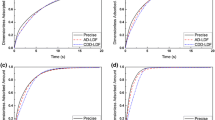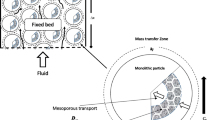Abstract
The importance of adsorption induced convection in the macropores of a bidisperse adsorbent particle is studied for a step change in mole fraction or total pressure at the surface of the particle. Material balance equations for a binary gas mixture are written for both the macropores and the macropores with allowance for convection in the macropores, which is described by Darcy's law. The coupled set o1' partial differential equations is solved by orthogonal collocation. The enhancement in mass transfer as a result of convection is assessed by comparing the fractional uptake curves obtained with and without allowance for convection. Both equilibrium-based and kinetic-based separation processes are considered. The effect of the presence of convection in determining the controlling diffusional resistance (macropore or micropore) is also examined. Due to inclusion of convection no single non-dimensional group alone can determine the relative importance of macropore and micropore resistances. Results show that convection can significantly affect the performance of an equilibrium-based macropore diffusion controlled process and that the enhancement in mass transfer is more for a particle with a high value of Darcy permeability.
Similar content being viewed by others
Abbreviations
- C :
-
Darcy's coefficient of convective flow, m2
- c :
-
concentration, mol/m3 gas
- D :
-
diffusion coefficient in micropore or macropore, m2/s
- K :
-
Knudsen diffusion coefficient, m2/s
- k :
-
linear isotherm coefficient, m3 gas/m3 microspheres
- N :
-
flux in macropores, mol/m2 s
- P :
-
pressure, Pa
- q :
-
adsorbed-phase concentration, mol/m3 microspheres
- R :
-
gas constant, J/mol K
- t :
-
time, s
- y :
-
mole fraction
- Ξ :
-
porosity of an adsorbent particle
- Λ :
-
partition ratio
- µ:
-
viscosity of gas, kg/m s
- τ :
-
dimensionless time
- τ p :
-
particle tortuosity
- A, B, i :
-
componentsA, B, i
- m :
-
micropore
References
Allawi Z.M.and D.J. Gunn. “Flow and Diffusion of Gases Through Porous Substrates“,A.I.Ch.E. J,33, 766–775 (1987).
Doong, S.J. and R.T., Yang. “Bidisperse Pote Diffusion Model for Zeolite Pressure Swing Adsorption.”AJCh.E.J. 33, 1045–1049 (1987).
Farooq, S. and D.M. Ruthven, “Numerical Simulation of a Kineticallc Controlled Pressure Swing Adsorpfion Bulk Separation Process Based on a Diffusion Model.”Chem. Engng. Sci. 46. 2213–2224 (1990)
Hassan M.M., D.M. Ruthven and N.S. Raghavan, “Air Separation by Pressure Swing Adsorption on a Cabon Molecular Sieve”Chem. Engng. Sieve”41, 1333–1343 (1986)
Hindmarsh, A.C., LSODE and LSODI, “Two New Initial-Value Ordinary DiIletential Equation Solcers,”,ACM-SIGNUM Newletter 15(4), 10–11 (1980)
Kruglov, A. and R. Aris, “Adsorption Kinetics for the Case of Step and S-Shaped Isotherm.A.I.Ch.E.J. 41. 2395–2398 (1995).
Lu, Z., J.M. Loureiro, M.D. LeVan, and A.E. Rodrigues, “Intraparticle Concoction Effect on Prssurization and Blowdown of Adsorhers,”;A.I.Ch.F.J.,38, 857–867 (1992a).
Lu, Z., J.M. Loureiro. M.D. LeVan, and A.E. Rodriaues, “Effect of Intraparticfe Forced Comcclion on Gas Desorption Irom Fixed Beds Containing “Large-Pore” Adsorbents.”Ind. Engng. Chem Res. 31, 1530–1540 (1992b).
Raghavan, N.S. and D.M. Ruthven “Pressure Swing Adsorption Part III: Numerical Simulation of a Kinetically Cortlrolled Bull Gas Separation,”A.I.Ch.E.J. 31, 2017–2025 (1985)
Ruckenmein, E., A. S. Vaudtanathan and G.R. Youngquist “Sorption by Solids with Bidisperse Pore Structures,”Chem Engng. Sci 26 1305–1318 (1971)
Ruthven, D.M. and K. F. Lougling “The Diffusional Resistance of Molecular Sieve Pellets,”Can. J. Chem. Eng. 30, 550–552 (1972)
Scott, D.S. and E.A.L. Dullien, “Diffusion of Ideal Gases un Capillaries and Porous Solids,”A.I.Ch.J.,8, 113–117 (1962).
Taqci, S. M. and M.D. Le Van Role of Covection and Diffusion in a Single Pore With Adsorptive Walls”Adsorption 2, 199–309 (1996).
Yang, R. T. and S.I. Doong, “Gas Separation by Pressure Swirl, Adsorption A Pore-Diffusion Model for Bulk SeparationA.L.Ch.E.J. 31, 1829–1842 (1985)
Author information
Authors and Affiliations
Rights and permissions
About this article
Cite this article
Taqvi, S.M., Vishnoi, A. & Levan, M.D. Effect of macropore convection on mass transfer in a bidisperse adsorbent particle. Adsorption 3, 127–136 (1997). https://doi.org/10.1007/BF01650236
Received:
Revised:
Accepted:
Published:
Issue Date:
DOI: https://doi.org/10.1007/BF01650236




